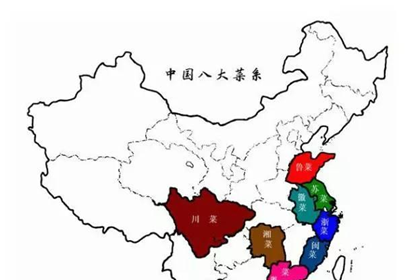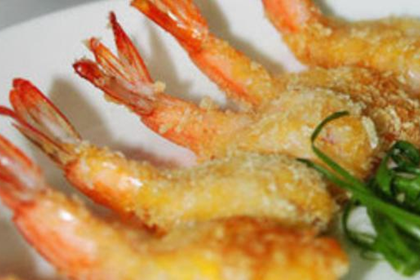info@chinaadventure.org
86-18008011324
Search
Chinese food culture refers to a set of local cuisine techniques and flavors formed through a long historical evolution in a certain region due to the differences in climate, geography, history, products and eating customs, and recognized by all parts of the country. Chinese food is generally divided into eight major cuisines according to geographical location. They are Anhui, Fujian, Guangdong, Hunan, Jiangsu, Shandong, Sichuan and Zhejiang Cuisine. Regional cuisine varies from region to region and from people to people. Naturally, they are also strongly influenced by the main crops that grow in each particular area.


Shandong Cuisine (Lu Cuisine)
Modern Shandong cuisine evolved from Jinan, Jiaodong and Confucian cooking styles. Jinan is best known for its barbecue and frying techniques, Jiaodong for its fresh seafood preparation and Confucian for a royal or aristocratic cuisine. Shandong food is characterized by freshness, aroma and tenderness. The recipe includes a variety of seafood and vegetables, especially onions and cabbage. Many Shandong dishes are a bit spicy because they use local vinegar. Unlike the rest of China, five grains are widely used here. Wheat, corn, sweet potatoes, soybeans and millet are the main ingredients for porridge, steamed buns and pasta. Typical dishes include bird's nest soup, sweet and sour yellow carp, Dezhou braised chicken, and braised sausage.


Sichuan Cuisine (Chuan Cuisine)
Sichuan cuisine, often called Szechuan Cuisine in the west, is one of the most famous Chinese cuisines in the world. Sichuan cuisine is characterized by its spicy and stimulating taste, rich taste, and emphasis on the use of pepper. Pepper and Sichuan peppercorns also go hand in hand, producing typically exciting flavors. Garlic, ginger and fermented black beans are also used in the cooking process. Wild vegetables and animals are often chosen as ingredients, while frying, frying without oil, marinating and stewing are basic cooking techniques.
If you eat Sichuan food and find it too bland, you may not be eating authentic Sichuan food. Chilies and prickly ash are used in many dishes to give it a distinctive spicy flavor, which is called "ma" in Chinese. It often leaves a slight numbness in the mouth. Sichuan hot pot is probably the most famous hot pot in the world. The most famous is Yuanyang hot pot, which is half hot and half clear. Typical dishes include Stir-Fried Tofu with Minced Beef in Spicy Sauce, Couple's Spicy Lung Slices, Kungpao Chicken Cubes and Lamp Shadow Beef.

Cantonese Cuisine (Yue Cuisine)
Cantonese cuisine was formed during the Ming and Qin Dynasties. In the process of development, it has borrowed the culinary essence of northern China and western food, while retaining the traditional local flavor.
The most distinctive cooking methods are salt or wine cooking, roasting in a pan, and soft frying. Cantonese cuisine emphasizes a unique blend of flavors. For example, a condiment is a mixture of onions, garlic, sugar, salt and spices. This gravy is a mixture of peanut oil, ginger, onion, Shaoxing wine, sugar crystals, fennel, cinnamon, licorice, cloves, ginger powder and tangerine peel. Spiced salt is made from refined salt, sugar, spice powder and fennel. These seasonings, along with oyster sauce, fish sauce, clam oil, curry and other popular condiments, give Cantonese cuisine its special flavor.
For many Cantonese, anything that can walk, crawl, fly or swim is edible, such as cats, snakes, bee pupae and so on. In order to respect the eating habits of other regions, some materials were eliminated. As a result, many strange foods no longer appear in today's Cantonese cuisine. Typical dishes include Eight treasures Stuffed Duck, Dim Sum and Double Layer Milk Cream.


Jiangsu Cuisine (Su Cuisine)
Jiangsu cuisine, also known as Su cuisine, is one of the eight major Chinese cuisines with a history of more than 2,000 years. Most Jiangsu cuisines preserve the original flavor of the ingredients very well. The chefs are especially good at simmering, braising, and stewing. Jiangsu cuisine is rich in Umami, natural, mild and slightly sweet, with original ingredients. The dishes are delicate, like works of art. Rich ingredients, mainly freshwater fish, river fish, shad and other seafood, knife fish, balloon fish, silver fish, Yangcheng lake crab, carp and so on. Vegetables include lotus root, chestnuts, bamboo shoots, winter shoots and water chestnuts. Famous Jiangsu dishes include Brine-Boiled Duck, Sweet and Sour Mandarin Fish, Braised Meat Balls in Brown Sauce, Beggar’s Chicken and so on.


Fujian Cuisine (Min Cuisine)
Fujian cuisine is usually divided into Minnan cuisine, Minxi cuisine, Fuzhou cuisine and Quanzhou cuisine. The food is usually lightly flavored, with the main flavors being sweet and sour. A typical Fujian dish consists of mincing the ingredients and then quickly boiling or frying them or adding them to the soup.
Some of the most famous Fujian dishes include: The Monk Jumps Over the Wall, Fried Xi Shi's Tongue and Jade Pearl Abalone.


Zhejiang Cuisine (Zhe Cuisine)
Zhejiang cuisine is famous for its fresh, delicate appearance and mellow fragrance. There are at least three styles of Hangzhou cuisine, Shaoxing cuisine and Ningbo cuisine. Among them, Hangzhou has a wide variety of dishes, with more bamboo shoots, Shaoxing dishes mainly poultry and freshwater fish, Ningbo dishes mainly seafood. Famous dishes here are west lake fish in vinegar, sweet and sour ribs and west lake beef soup. Some of the most famous Zhejiang dishes include: West-lake Braised Fish in Vinegar, Sweet and Sour Pork Fillet and West Lake Beef Soup.


Hunan Cuisine (Xiang Cuisine)
Hunan cuisine is famous for its spicy, crisp, fragrant, fresh flavor and deep color. Smoked and pickled products are used more frequently in dishes. Equally important to Hunan cuisine is the art of cutting meat and vegetables, which is both pleasing to the eye and adds tenderness to the dish. The common cooking techniques of Xiang cuisine include stewing, frying, pot-roasting, braising, and smoking. What's more, the menu of Hunan cuisine changes with the seasons. Some of the most famous Hunan dishes include:Steamed Fish Head with Chopped Chili, Steamed Preserved Meat, Chairman Mao’s Red Braised Pork,Changsha Stinky Tofu and Tasty Lobster.


Anhui Cuisine (Huan Cuisine)
Anhui cuisine, abbreviated as "Huan cuisine", is one of the eight major cuisines in China. Anhui cuisine consists of dishes from three geographical regions: southern Anhui, the Yangtze River and the coastal areas of the Hui nationality.
The distinctive feature of Anhui cuisine lies not only in the careful selection of cooking materials, but also in the strict control of the cooking process.
Most of the ingredients of Anhui cuisine, such as Pangolins, stone frogs, mushrooms, arbutus, tea, bamboo shoots and red dates, come from mountainous areas. Huangshan is rich in cooking materials. The white bamboo shoots growing in Huangshan can be made into delicious food. Shiitake mushroom is a kind of high-grade mushroom that grows on old trees and tastes good. Typical dishes include Steamed Stone Frog, Bamboo Shoots Cooked with Sausage and Dried Mushroom, Li Hongzhang Hotchpotch.


we’ll reply you in 24 hours!
Copyright © 2012-2024 All Rights Reserved to chinaadventure.org